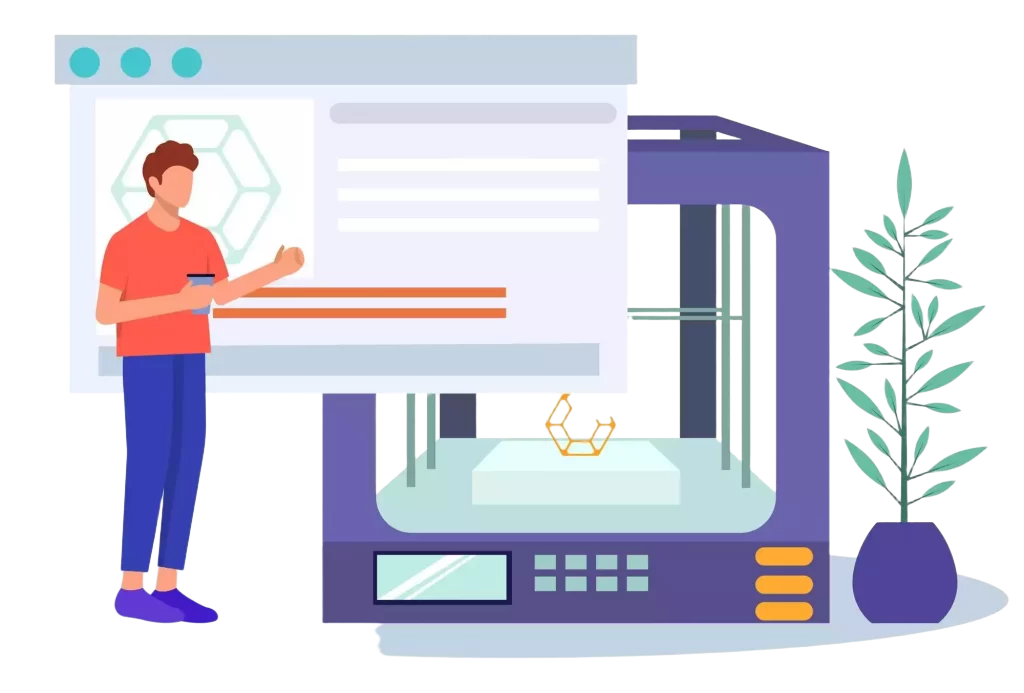3D Printing
What is 3D Printing?
3D printing, also known as additive manufacturing, is a process that creates three-dimensional objects from digital models by adding material layer by layer. This technique allows for the production of complex geometries that are often challenging to achieve with traditional manufacturing methods.

Key Features
Design Flexibility
3D printing enables the creation of intricate and complex designs that are difficult or impossible to produce using conventional methods.
Rapid Prototyping
It allows for quick production of prototypes, accelerating the design and development process.
Customization
Each item can be customized without additional tooling or costs, making it ideal for personalized products.
Material Efficiency
As an additive process, it uses only the material necessary for the part, reducing waste compared to subtractive manufacturing methods.
How Does 3D Printing Work?
The 3D printing process typically involves the following steps:
- Design Creation: A digital 3D model is created using Computer-Aided Design (CAD) software.
- File Preparation: The 3D model is converted into a format compatible with the printer, commonly an STL file, and then sliced into thin horizontal layers using slicing software.
- Printing: The 3D printer builds the object layer by layer, following the design specifications.
- Post-Processing: After printing, the object may require cleaning, curing, or other finishing processes to achieve the desired properties.
Types of 3D Printing
There are several 3D printing technologies, each suited for different applications:
- Fused Deposition Modeling (FDM): Builds parts by melting and extruding thermoplastic filament, which a printer nozzle deposits layer by layer.
FORMLABS - Stereolithography (SLA): Uses a laser to cure liquid resin into hardened plastic in a layer-by-layer process.
- Selective Laser Sintering (SLS): Employs a laser to sinter powdered material, binding it together to create a solid structure.
Materials Used in 3D Printing
A wide range of materials can be used in 3D printing, including:
- Plastics: Such as ABS, PLA, and nylon.
- Metals: Including stainless steel, titanium, and aluminum.
- Resins: Used primarily in SLA printing for high-resolution parts.
- Ceramics and Composites: For specialized applications requiring specific material properties.
Advantages of 3D Printing
- Speed: Parts can be produced within hours, expediting the prototyping process.
TWI GLOBAL - Cost-Effectiveness: Eliminates the need for expensive tooling, reducing manufacturing costs for low to medium production runs.
- Customization: Allows for easy customization without additional costs.
- Sustainability: Reduces material waste compared to traditional manufacturing methods.
Applications of 3D Printing
3D printing is utilized across various industries, including:
- Aerospace and Automotive: For prototyping and producing lightweight components.
- Healthcare: In creating custom prosthetics, implants, and anatomical models.
- Architecture: For building models and complex structures.
- Consumer Goods: In the production of customized products and prototypes.
The Future of 3D Printing
The future of 3D printing holds promising advancements:
- Material Development: Expansion of printable materials with enhanced properties.
- Speed and Efficiency: Improvements in printing speed and reduction in production costs.
- Integration with Traditional Manufacturing: Combining additive and subtractive manufacturing for optimized production.
- Mass Customization: Enabling large-scale production of customized products.

7 Tips for Choosing a 3D Printing Service
Assess Material Options
- Ensure the service offers materials that meet your project's requirements. 3D PRINTING SHOP
Evaluate Technology Capabilities
- Different printing technologies offer varying levels of detail and strength; choose one that aligns with your needs.
Review Experience and Expertise
- Look for a provider with a proven track record in your industry.
Check Customer Feedback
- Read reviews and testimonials to gauge customer satisfaction.
Consider Turnaround Time
- Ensure the service can meet your project's deadlines.
Analyze Cost Structure
- Compare pricing to ensure it fits within your budget without compromising quality.
Assess Post-Processing Services
- Determine if the provider offers finishing services that meet your specifications.

We connect buyers with trusted suppliers to ensure you get the right products for your business needs.
IndustrialX is the ultimate one-stop marketplace for businesses in the automotive and industrial sectors, providing a seamless way to find, compare, and purchase high-quality industrial equipment.
Manufacturing Services
Manufacturing Capabilities to Meet Your Needs
Customer base
manufacturers
CNC Machining
A precise manufacturing process using computerized machines to cut, shape, and finish materials with high accuracy.
Read more3D Printing
A process that creates three-dimensional objects layer by layer from digital models, enabling rapid prototyping and customization.
Read moreSheet Metal
The process of shaping metal sheets into desired forms using cutting, bending, and stamping techniques.
Read moreInjection Molding
A manufacturing process where molten material is injected into a mold to create parts with high precision and detail.
Read moreDie Casting
A process where molten metal is forced into a mold to create durable and complex parts with precise detail.
Read moreAssembly Products
The process of putting together different components to create a finished product, ensuring functionality and quality.
Read more
